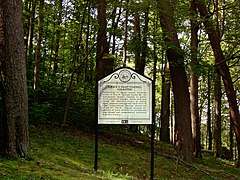Hawks Nest Tunnel disaster
The Hawks Nest Tunnel disaster was a large-scale incident of occupational silicosis as the result of the construction of the Hawks Nest Tunnel near Gauley Bridge, West Virginia, as part of a hydroelectric project. This project is considered to be one of the worst industrial disasters in American history.[1]
 Historical marker "Hawks Nest Tunnel Disaster" | |
| Date | 1930-1935 |
|---|---|
| Location | Gauley Bridge, West Virginia |
| Coordinates | 38°07′20″N 81°07′42″W |
| Cause | occupational silicosis |
| Deaths | 476 to 1,000 (estimated) |
Tunnel
To generate electricity for a plant downstream at Alloy, Union Carbide's Kanawha and New River Power Company subsidiary decided to divert the New River to improve its power generation ability. Beginning in 1927, its contractor Rinehart & Dennis began construction of the 3-mile (4.8 km) tunnel carrying the river under Gauley Mountain. A dam was constructed immediately below Hawks Nest to divert most of the New River flow into the tunnel. It then re-enters the river near Gauley Bridge leaving a section known as "the Dries" in between.
Silica
During the construction of the tunnel, workers found the mineral silica and were asked to mine it for use in electroprocessing steel. Facing widespread unemployment during the Great Depression, about three thousand men, three-fourths of whom were Black, came to West Virginia to dig the tunnel. They worked ten- to fifteen-hour shifts, using drills and dynamite to mine the sandstone, which has a high silica content. The workers completed the project more than twice as fast as original projections.[2] They were not given any masks or breathing equipment to use while mining, although management wore such equipment during inspection visits.[3] They were denied breaks and even forced to work at gunpoint.[2] As a result of the exposure to silica dust, many workers developed silicosis, a debilitating lung disease caused by the effects of silica dust in the lungs. A large number of the workers eventually died from silicosis, in some cases as quickly as within a year.[3]
There are no definitive statistics as to the death toll from the Hawks Nest disaster. According to a historical marker on site, there were 109 admitted deaths. A Congressional hearing placed the death toll at 476.[4] Other sources range from 700 to over 1,000 deaths amongst the 3,000 workers.[5] Many of the workers at the site were African-Americans from the southern United States who returned home or left the region after becoming sick, making it difficult to calculate an accurate total.[6]
Cultural references
- Muriel Rukeyser wrote a poetry sequence, "The Book of the Dead", about this disaster, which can be found in her book, U.S. 1 (published in 1938).
- Vladimir Pozner's Disunited States (chapter "Cadavers, By-products of Dividends"), Seven Stories Press, 2014 (Les Etats-Désunis was originally published in French in 1938)
- Hubert Skidmore, a West Virginian, immortalized the tragic events from the common man's perspective in his book Hawk's Nest which followed the fictional accounts of several tunnel workers and their families. Skidmore wrote the book only a few years after the incident (originally published in 1941) and likely used direct sources for his story development.
- Hawks Nest is also mentioned in a section entitled Dying for a Living: The Hawk's Nest Incident in the book Trust Us, We're Experts by Sheldon Rampton and John Stauber.
- In the young adult fiction novel The Miner's Daughter by Gretchen Moran Laskas, the main character's father and older brother go to work on the Hawks Nest Tunnel after their coal mine is shut down. The two men return less than a year later because the father is gravely ill with a cough.[7]
- Dwight Harshbarger, a native West Virginian, wrote the novel Witness at Hawks Nest.[8]
- Under the pseudonym of "Pinewood Tom," Josh White wrote and sang "Silicosis Is Killing Me," describing the plight of the miners.[9]
Historical marker
A nearby West Virginia Historical Marker at Hawks Nest State Park reads:[4]
Construction of nearby tunnel, diverting waters of New River through Gauley Mt for hydroelectric power, resulted in state's worst industrial disaster. Silica rock dust caused 109 admitted deaths in mostly black, migrant underground work force of 3,000. Congressional hearing placed toll at 476 for 1930-35. Tragedy brought recognition of acute silicosis as occupational lung disease and compensation legislation to protect workers.
See also
- Air Hygiene Foundation, founded by the Mellon Institute of Industrial Research in response to the disaster
- Hawks Nest State Park
- New River
References
- Cherniack, Martin (1986). The Hawk's Nest Incident. Yale University Press. ISBN 978-0-300-04485-0.
- Lancianese, Adelina (January 20, 2019). "Before Black Lung, The Hawks Nest Tunnel Disaster Killed Hundreds". National Public Radio. Retrieved June 5, 2020.
- "The Human Cost of Construction". DiMarco Araujo Montevideo. Retrieved 15 March 2016.
- "Hawk's Nest Tunnel Disaster". West Virginia Department of Culture and History. Retrieved 2008-11-25.
- Spangler, Patricia (February 19, 2008). The Hawks Nest Tunnel. Wythe-North Publishing. ISBN 978-0-9801862-0-8.
- Keenan, Steve (April 2, 2008). "Book explores Hawks Nest tunnel history". The Fayette Tribune. Archived from the original on April 7, 2008. Retrieved November 25, 2008.
- Laskas, Gretchen Moran (2007-02-06). The Miner's Daughter. Simon & Schuster Children's Publishing. ISBN 978-1-4169-1262-0.
- Harshbarger, Dwight (2009). Witness at Hawks Nest. Publishers Place. Archived from the original on February 9, 2011.
- "PopMusic: Silicosis is Killing Me Public health in pop music," Arti Virkud, 2X2 Project
External links
- About the Hawk's Nest Incident
- Silicosis: From Public Menace to Litigation Target by Wade Goodwyn, National Public Radio
- Work Safely With Silica
- "The Book of the Dead" by Muriel Rukeyser